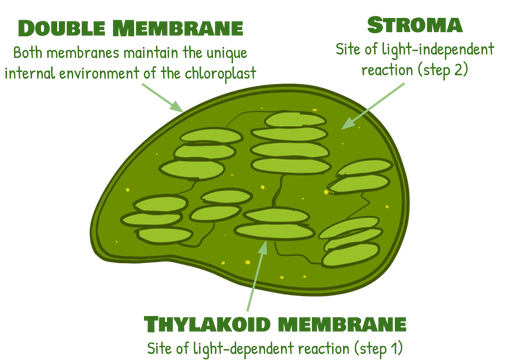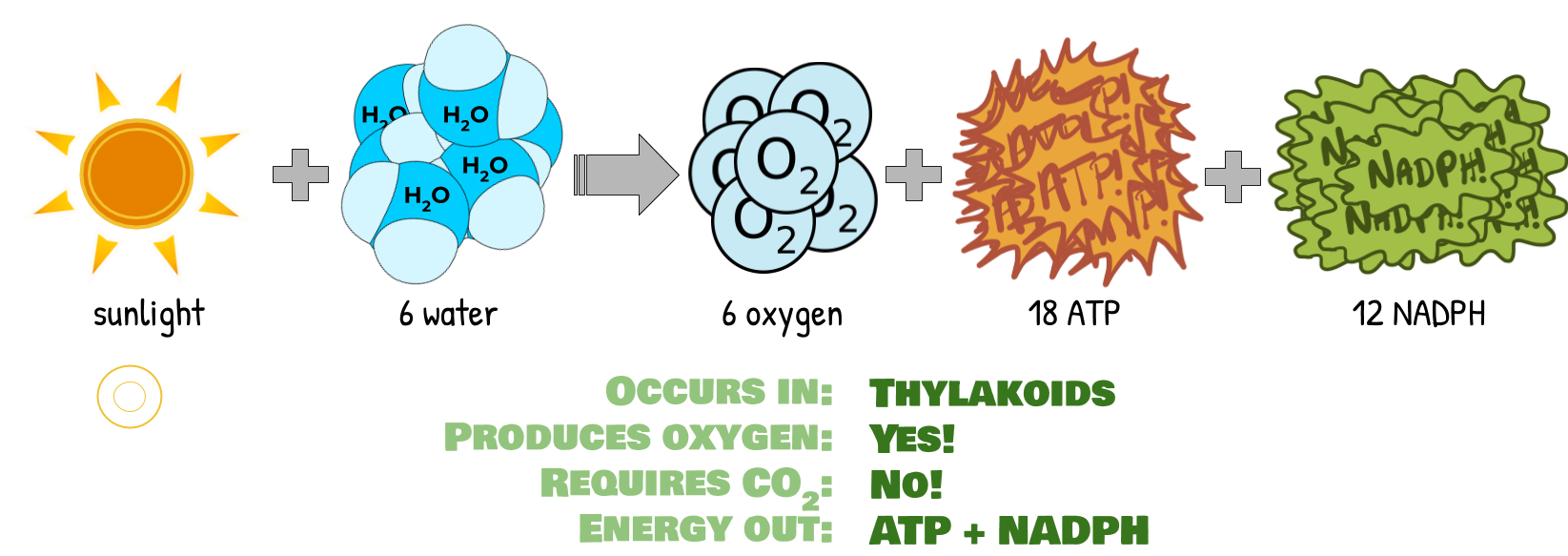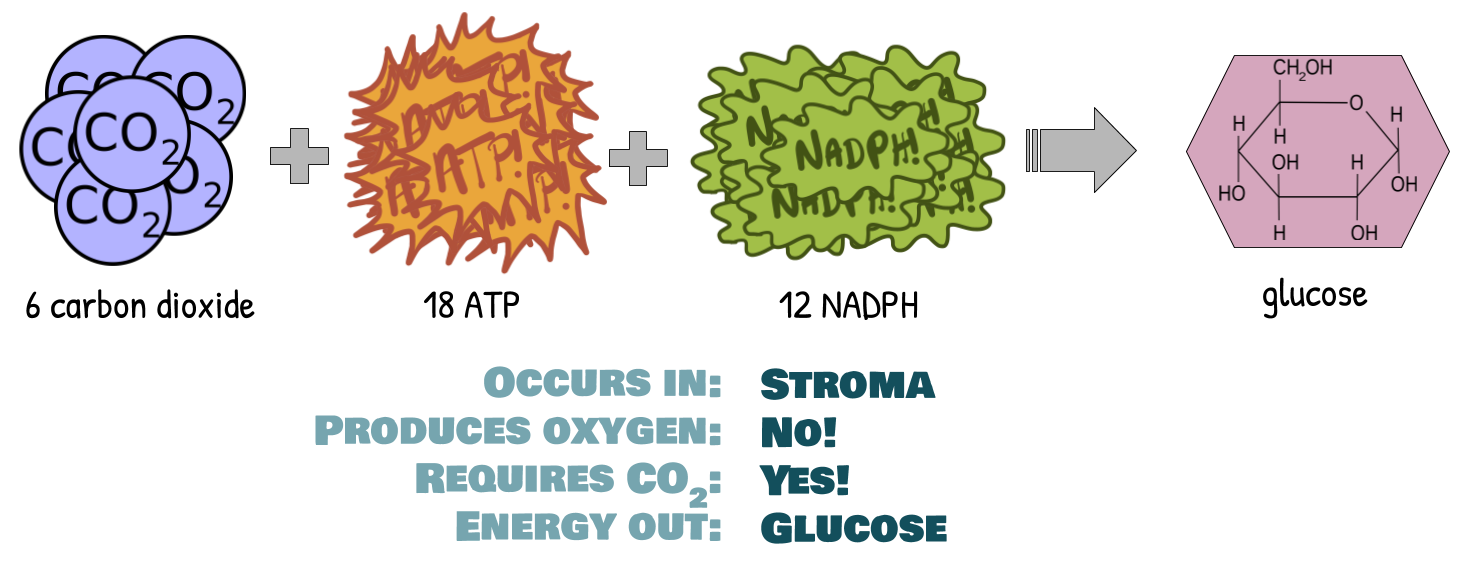The Photosynthesis Process
Now that you know the basic mechanism of photosynthesis (once again: sun energy → food energy), and now that you know that the mechanism is not just cell respiration backwards (though there are similarities), let’s get into more detail.
Photosynthesis is split into two parts: light-dependent reactions and light-independent reactions (also called the Calvin Cycle). As you might guess from the names, the first step requires sunlight and the second step does not directly require sunlight. Both steps occur inside of a specialized organelle called the chloroplast.
Photosynthesis is split into two parts: light-dependent reactions and light-independent reactions (also called the Calvin Cycle). As you might guess from the names, the first step requires sunlight and the second step does not directly require sunlight. Both steps occur inside of a specialized organelle called the chloroplast.
The Chloroplast
The chloroplast is a specialized organelle found in cells that do photosynthesis. Like mitochondria (and all organelles, and pretty much everything in biology), it has a specialized structure that helps it to do its specialized function. The structure of the chloroplast looks like this:
You’ll notice a few important features:
The main important things to understand are (1) the idea of localization and how it relates to the importance of organelles, which was discussed in more detail when we talked about mitochondria, and (2) where each step of photosynthesis occurs.
- Double membrane: The chloroplast has a double membrane. Unlike with the mitochondria, however, both membranes are mainly used in maintaining the inner environment of the chloroplast. Like with mitochondria, this is related to the ideas of specialization and localization, or creating a unique environment inside of the chloroplast, where all of the important molecules for a specific function are put in close proximity to each other. The inner membrane has a secondary function in producing certain pigments. Neither plays a functional role in photosynthesis.
- The thylakoid membrane. This is where the light-dependent reaction of photosynthesis occurs. You’ll see that the shape creates a lot of surface area, or space to do the light-dependent reaction. It can be compared to the inner membrane of the mitochondria.
- The stroma. This is where the light-independent reaction occurs. Don’t get confused: just because the thylakoid membrane is most functionally similar to the inner membrane of the mitochondria doesn’t mean the stroma (most similar to the matrix of mitochondria) is found inside the thylakoids.
The main important things to understand are (1) the idea of localization and how it relates to the importance of organelles, which was discussed in more detail when we talked about mitochondria, and (2) where each step of photosynthesis occurs.
The Light-Dependent Reaction
The first step, the light-dependent reaction, occurs in the thylakoid membrane of the chloroplast. The light-dependent reaction of photosynthesis is somewhat similar to a backwards electron transport chain in cell respiration, in that energy is taken in to form temporary energy-storage molecules and it involves a chain of complex proteins.
In the light-dependent reaction, a photon (a tiny piece of light) from the sun hits a specialized protein called a photosystem, which contains a pigment called chlorophyll. Chlorophyll is the pigment that makes plants green. Chlorophyll absorbs that photon from the sun, making it higher energy. Electrons from this process travel down an electron transport chain, similar to the one in cell respiration, but backwards. Like a backwards electron transport chain, oxygen is made from water in this process, and NADPH (which is similar to NADH) is made in this process. (Compare to cell respiration, where oxygen is turned into water and NADH is used). NADPH is an energy-storing molecule. You can remember that NADPH is found in plants, because it has a P! (The P does not actually stand for “plant”). NADPH is used in the light-independent reaction.
Unlike just a backwards electron transport chain, the chain is still used to make a proton gradient that powers ATP synthase (like a forwards electron transport chain). About 18 ATP are made (you don’t have to know this number). The redox reactions are backwards because something is being made instead of consumed, but this doesn’t change the chemistry that is able to power a proton gradient.
In the light-dependent reaction, a photon (a tiny piece of light) from the sun hits a specialized protein called a photosystem, which contains a pigment called chlorophyll. Chlorophyll is the pigment that makes plants green. Chlorophyll absorbs that photon from the sun, making it higher energy. Electrons from this process travel down an electron transport chain, similar to the one in cell respiration, but backwards. Like a backwards electron transport chain, oxygen is made from water in this process, and NADPH (which is similar to NADH) is made in this process. (Compare to cell respiration, where oxygen is turned into water and NADH is used). NADPH is an energy-storing molecule. You can remember that NADPH is found in plants, because it has a P! (The P does not actually stand for “plant”). NADPH is used in the light-independent reaction.
Unlike just a backwards electron transport chain, the chain is still used to make a proton gradient that powers ATP synthase (like a forwards electron transport chain). About 18 ATP are made (you don’t have to know this number). The redox reactions are backwards because something is being made instead of consumed, but this doesn’t change the chemistry that is able to power a proton gradient.
You may be wondering why we don’t just stop here with photosynthesis, since we’ve already made ATP, and that’s sort of the end goal anyways. The answer is that ATP is really unstable, and plants need to be able to save energy for later, when there’s no sun: like winter, or nighttime. So they keep going to turn that energy into sugar, which is stored for later. That sugar can also be turned into starch, which is even longer-term storage.
Here’s a video of the light-dependent reactions. It is helpful to understand, but the main details you need to remember are that this reaction involves chlorophyll absorbing energy from the sun and that the energy that gets absorbed is then transferred to NADPH and ATP:
Here’s a video of the light-dependent reactions. It is helpful to understand, but the main details you need to remember are that this reaction involves chlorophyll absorbing energy from the sun and that the energy that gets absorbed is then transferred to NADPH and ATP:
Light-Independent Reaction
The second step of photosynthesis is called the light-independent reaction or the Calvin Cycle. As you might guess from the name, it does not require any sunlight. The Calvin Cycle takes place in the stroma (middle bit) of the chloroplast. The Calvin Cycle is somewhat similar to a backwards Krebs Cycle plus the intermediate step and glycolysis of cellular respiration, in that energy from ATP and NADPH is used to build sugar from carbon dioxide.
The energy from ATP and NADPH that were produced in the light-dependent reactions is used to break the bonds of water and CO₂ molecules. Enzymes then reassemble the molecules to make glucose. This involves the help of a molecule called RuBP, which is recycled by the end of the process (hence the name, the Calvin Cycle).
The energy from ATP and NADPH that were produced in the light-dependent reactions is used to break the bonds of water and CO₂ molecules. Enzymes then reassemble the molecules to make glucose. This involves the help of a molecule called RuBP, which is recycled by the end of the process (hence the name, the Calvin Cycle).
Here’s a video of the Calvin Cycle. Again, you don’t need to know every detail, but you should know that the energy from ATP and NADPH is used to build sugar from carbon dioxide:
Photosynthesis Versus Cellular Respiration
You may find it helpful to compare photosynthesis and cellular respiration:
|
Summary
This video gives a great overview of photosynthesis:
If you want a deeper look at how these mechanisms work, you can watch this video. You don’t need to know all of the details of the mechanisms, just the main idea of the two steps of photosynthesis (light dependent and light independent), but it can be helpful to see the detail for your conceptual understanding:
You should understand:
- That photosynthesis happens inside of chloroplasts, which are a specialized organelle with a distinct structure to help with its distinct function.
- The thylakoid is the site of the light-dependent reaction
- The thylakoid is the site of the light-dependent reaction
- That the light-dependent reaction uses a protein called chlorophyll to turn sunlight energy into temporary chemical energy in the form of ATP and NADPH, which is a lot like NADH. The light-dependent reaction also makes oxygen from water.
- That the light-independent reaction or Calvin cycle uses the energy from ATP and NADPH (produced in the light-dependent reaction) to turn carbon dioxide into glucose.
- That the reactions of photosynthesis share many similarities with cellular respiration, but it is more complex than just cell respiration backwards. You should understand the differences highlighted in the chart above.
Learning Activity
Contributors: Emma Moulton, Kathleen Yu, and Eli Levine



